Exploring the Potential Applications of Wool Fibers in Composite Materials: A Review
Abstract
1. Introduction
2. Physical and Chemical Properties of Wool Fibers
2.1. Physical Properties
2.2. Crimps
2.3. Moisture Content
2.4. Felting
2.5. Mecchanical Properties
2.6. Chemical Properties
2.7. Effect of Acids
2.8. Effect of Alkalis
3. Wool Fibers-Based Composites
3.1. Wool Fiber Reinforcement in Cement-Based Composites
Importance of Wool Fiber Size and Shape in Building Composites
3.2. Wool Fiber Reinforcement in Polymer-Based Composites
4. Importance of Wool Fiber-Matrix Adhesion in Composites
5. Preparation Techniques of Wool Fiber Composites
5.1. Hand-Lay-Up
5.2. Spray-Up
5.3. Resin Transfer Molding (RTM)
5.4. Vacuum-Assisted Resin Transfer Molding (VaRTM)
5.5. Resin Film Infusion (RFI)
5.6. Compression Molding
5.7. Injection Molding
- (a)
- Loading the cylinder;
- (b)
- Mold closing;
- (c)
- Polymer plasticization;
- (d)
- Injection/pressure;
- (e)
- Cooling;
- (f)
- Composite removal.
6. Application of Wool Fiber Reinforced Composites
7. Limitations, Challenges, and Future Perspectives Related to the Incorporation of Wool Fibers into Composite Materials
8. Conclusions
Funding
Conflicts of Interest
References
- Abramovich, H. 1—Introduction to Composite Materials; Woodhead Publishing: Cambridge, UK, 2017; pp. 1–47. ISBN 978-0-08-100410-4. [Google Scholar]
- Harris, B. Engeneering Composite Materials; The Institute of Materials: London, UK, 1999. [Google Scholar]
- Fernandes, F.A.O.; Jose, S.; Thomas, S. Chapter 1—Introduction to natural fiber composites. In Wool Fiber Reinforced Polymer Composites; The Textile Institute Book Series; Thomas, S., Jose, S., Eds.; Woodhead Publishing: Cambridge, UK, 2022; pp. 1–13. ISBN 978-0-12-824056-4. [Google Scholar]
- Jose, S.; Thomas, S.; Jibin, K.P.; Sisanth, K.S.; Kadam, V.; Shakyawar, D.B. Surface modification of wool fabric using sodium lignosulfonate and subsequent improvement in the interfacial adhesion of natural rubber latex in the wool/rubber composites. Ind. Crops Prod. 2022, 177, 114489. [Google Scholar] [CrossRef]
- Available online: https://single-market-economy.ec.europa.eu/sectors/textiles-ecosystem/eliit/learn/partnerships/cw-circular-wool_en (accessed on 19 June 2024).
- Gallico, L. La Lana; Eventi & Progetti: Palermo, Italy, 2000. [Google Scholar]
- Karim, S.A.; Gupta, N.P.; Shakyawar, D.B.; Ammayappan, L. Wool fiber: Production, properties and processing. Handb. Anim. Husb. 2013, 1163–1218. [Google Scholar]
- Kumar, A.; Prince, L.L.; Jose, S. Sustainable wool production in India. In Sustainable Fibres and Textiles; Elsevier: Amsterdam, The Netherlands, 2017; pp. 87–115. [Google Scholar]
- Lakshmanan, A. Chapter 4—Physical and chemical properties of wool fibers. In Wool Fiber Reinforced Polymer Composites; The Textile Institute Book Series; Thomas, S., Jose, S., Eds.; Woodhead Publishing: Cambridge, UK, 2022; pp. 49–71. ISBN 978-0-12-824056-4. [Google Scholar]
- Ammayappan, L.; Shakyawar, D.B.; Krofa, D.; Pareek, P.K.; Basu, G. Lue addition of pashmina products: Present status and future perspectives—A review. Agric. Rev. 2011, 32, 91–101. [Google Scholar]
- Hearle, J.W.S. Physical properties of wool. Wool Sci. Technol. 2002, 34, 80–129. [Google Scholar]
- Peet, D.J.; Wettenhall, R.E.H.; Rivett, D.E. The chemistry of the cuticle surface of keratin fibers. Text. Res. J. 1995, 65, 58–59. [Google Scholar] [CrossRef]
- Lakshmanan, A.; Lee, J.S.; Jeyaraj, J.M.; Kochadai, A.S. Comparison of biopolymer finishing with functional finishing on wool fibre. Indian J. Fibre Text. Res. 2015, 40, 447–452. [Google Scholar]
- Mann, G.S.; Azum, N.; Khan, A.; Rub, M.A.; Hassan, M.I.; Fatima, K.; Asiri, A.M. Green Composites Based on Animal Fiber and Their Applications for a Sustainable Future. Polymers 2023, 15, 601. [Google Scholar] [CrossRef]
- Manivannan, J.; Rajesh, S.; Mayandi, K.; Rajini, N.; Ismail, S.O.; Mohammad, F.; Kuzman, M.K.; Al-Lohedan, H.A. Animal fiber characterization and fiber loading effect on mechanical behaviors of sheep wool fiber reinforced polyester composites. J. Nat. Fibers 2022, 19, 4007–4023. [Google Scholar] [CrossRef]
- Jóźwiak-Niedźwiedzka, D.; Fantilli, A.P. Wool-Reinforced Cement Based Composites. Materials 2020, 13, 3590. [Google Scholar] [CrossRef] [PubMed]
- Tiza, T.M.; Singh, S.K.; Kumar, L.; Shettar, M.P.; Singh, S.P. Assessing the potentials of Bamboo and sheep wool fiber as sustainable construction materials: A review. Mater. Today Proc. 2021, 47, 4484–4489. [Google Scholar] [CrossRef]
- Fantilli, A.P.; Jóźwiak-Niedźwiedzka, D. The effect of hydraulic cements on the flexural behavior of wool reinforced mortars. Acad. J. Civ. Eng. 2019, 37, 287–292. [Google Scholar]
- Fantilli, A.P.; Jóźwiak-Niedźwiedzka, D.; Gibas, K.; Dulnik, J. The compatibility between wool fibers and cementitious mortars. Acad. J. Civ. Eng. 2017, 35, 42–47. [Google Scholar]
- Dénes, O.; Florea, I.; Manea, D.L. Utilization of sheep wool as a building material. Procedia Manuf. 2019, 32, 236–241. [Google Scholar] [CrossRef]
- Alyousef, R.; Aldossari, K.; Ibrahim, O.; Mustafa, H.; Jabr, A. Effect of sheep wool fiber on fresh and hardened properties of fiber reinforced concrete. Int. J. Civ. Eng. Technol. 2019, 10, 190–199. [Google Scholar]
- Fantilli, A.P.; Jóźwiak-Niedźwiedzka, D. Influence of Portland cement alkalinity on wool-reinforced mortar. Proc. Inst. Civ. Eng. Mater. 2021, 174, 172–181. [Google Scholar] [CrossRef]
- Maia Pederneiras, C.; Veiga, R.; de Brito, J. Rendering mortars reinforced with natural sheep’s wool fibers. Materials 2019, 12, 3648. [Google Scholar] [CrossRef]
- Statuto, D.; Bochicchio, M.; Sica, C.; Picuno, P. Experimental development of clay bricks reinforced with agricultural by-products. In Proceedings of the ATAE2018 Symposium; Nikola Bilandžija: Berlin, Germany, 2018. [Google Scholar]
- Parlato, M.C.M.; Porto, S.M.C. Organized Framework of Main Possible Applications of Sheep Wool Fibers in Building Components. Sustainability 2020, 12, 761. [Google Scholar] [CrossRef]
- Štirmer, N.; Milovanović, B.; Sokol, J.M. Cement composites reinforced with sheep’s wool. In Proceedings of the International Symposium on Eco-Crete, Reykjavik, Iceland, 13–15 August 2014; Wallevik, O.H., Bager, D.H., Hjartarson, B., Wallevik, J.E., Eds.; pp. 271–278. [Google Scholar]
- Gradinaru, C.M.; Barbuța, M.; Șerbanoiu, A.A.; Babor, D. Investigations on the mechanical properties of concrete with sheep wool fibers and fly ash. In Bulletin of the Transilvania University of Brasov. Series I: Engineering Sciences; Transilvania University Press: Lexington, KY, USA, 2016; pp. 73–80. [Google Scholar]
- Cardinale, T.; Arleo, G.; Bernardo, F.; Feo, A.; De Fazio, P. Thermal and mechanical characterization of panels made by cement mortar and sheep’s wool fibres. Energy Procedia 2017, 140, 159–169. [Google Scholar] [CrossRef]
- Mobili, S.; Galán-Marín, C.; Rivera-Gómez, C. A New Affordable Masonry System Based on Unfired Clay Sandwich Panel. Proceedings 2018, 2, 1378. [Google Scholar] [CrossRef]
- Erkmen, J.; Yavuz, H.I.; Kavci, E.; Sari, M. A new environmentally friendly insulating material designed from natural materials. Constr. Build. Mater. 2020, 255, 119357. [Google Scholar] [CrossRef]
- Fiore, V.; Di Bella, G.; Valenza, A. Effect of sheep wool fibers on thermal insulation and mechanical properties of cement-based composites. J. Nat. Fibers 2020, 17, 1532–1543. [Google Scholar] [CrossRef]
- Asdrubali, F. Green and sustainable porous materials for noise control in buildings: A state of the art. In Proceedings of the SAPEM-Symposium on the Acoustics of Poro-Elastic Materials, Ferrara, Italy, 14–16 December 2011. [Google Scholar]
- Ferreira, D.; Cruz, J.; Fangueiro, R. Surface modification of natural fibers in polymer composites. In Green Composites for Automotive Applications; Woodhead Publishing: Cambridge, UK, 2018. [Google Scholar]
- Zariq, M.; Mohd Zubir, I.; Mohd, W.; Wan, W.; Rahman, A. Alternative Soundproof Material to Reduce Noise HVAC Round Duct System (Rockwool and Bamboo Fiber). Prog. Eng. Appl. Technol. 2021, 2, 683–693. [Google Scholar]
- Ablaoui, E.M.; Malendowski, M.; Szymkuc, W.; Pozorski, Z. Determination of Thermal Properties of Mineral Wool Required for the Safety Analysis of Sandwich Panels Subjected to Fire Loads. Materials 2023, 16, 5852. [Google Scholar] [CrossRef] [PubMed]
- Chanlert, P.; Ruamcharoen, P. Sound absorption properties of rigid polyurethane foam composites with rubber-wood sawdust as a natural filler. J. Phys. Conf. Ser. 2021, 1719. [Google Scholar] [CrossRef]
- Hadała, B.; Zygmunt-Kowalska, B.; Kuźnia, M.; Szajding, A.; Telejko, T. Thermal insulation properties of rigid polyurethane foam modified with fly ash- a comparative study. Thermochim. Acta 2024, 731, 179659. [Google Scholar] [CrossRef]
- Dahal, R.K.; Acharya, B.; Dutta, A. Thermal Response of Biocarbon-Filled Hemp Fiber-Reinforced Bioepoxy Composites. ACS Omega 2023, 8, 15422–15440. [Google Scholar] [CrossRef]
- Sezgin, H.; Duru, S.C.; Candan, C. Evaluation of Acoustic Performance of Hemp and Cotton Fiber Reinforced Thermoplastic Composites. Uludağ Univ. J. Fac. Eng. 2022, 27, 151–162. [Google Scholar] [CrossRef]
- Muchlisinalahuddin; Dahlan, H.; Mahardika, M.; Rusli, M. Cellulose-based Material for Sound Absorption And Its Application—A Short Review. BIO Web Conf. 2023, 77, 01003. [Google Scholar] [CrossRef]
- Lopez Hurtado, P.; Rouilly, A.; Vandenbossche, V.; Raynaud, C. A review on the properties of cellulose fibre insulation. Build. Environ. 2016, 96, 170–177. [Google Scholar] [CrossRef]
- Wei, J.; Meyer, C. Degradation mechanisms of natural fiber in the matrix of cement composites. Cem. Concr. Res. 2015, 73, 1–16. [Google Scholar] [CrossRef]
- Alyousef, R.; Alabduljabbar, H.; Mohammadhosseini, H.; Mohamed, A.M.; Siddika, A.; Alrshoudi, F.; Alaskar, A. Utilization of sheep wool as potential fibrous materials in the production of concrete composites. J. Build. Eng. 2020, 30, 101216. [Google Scholar] [CrossRef]
- Ceria, A.; Rombaldoni, F.; Rovero, G.; Mazzuchetti, G.; Sicardi, S. The effect of an innovative atmospheric plasma jet treatment on physical and mechanical properties of wool fabrics. J. Mater. Process. Technol. 2010, 210, 720–726. [Google Scholar] [CrossRef]
- Fantilli, A.P.; Sicardi, S.; Dotti, F. The use of wool as fiber-reinforcement in cement-based mortar. Constr. Build. Mater. 2017, 139, 562–569. [Google Scholar] [CrossRef]
- Mohammadi, M.; Taban, E.; Tan, W.H.; Che Din, N.B.; Putra, A.; Berardi, U. Recent progress in natural fiber reinforced composite as sound absorber material. J. Build. Eng. 2024, 84, 108514. [Google Scholar] [CrossRef]
- Gurunathan, T.; Mohanty, S.; Nayak, S.K. A review of the recent developments in biocomposites based on natural fibres and their application perspectives. Compos. Part A Appl. Sci. Manuf. 2015, 77, 1–25. [Google Scholar] [CrossRef]
- Ngo, T.-D. Chapter 8—Nanotechnological intervention in the wool composites. In Wool Fiber Reinforced Polymer Composites; The Textile Institute Book Series; Thomas, S., Jose, S., Eds.; Woodhead Publishing: Cambridge, UK, 2022; pp. 141–154. ISBN 978-0-12-824056-4. [Google Scholar]
- Kulkarni, M.B.; Gavande, V.; Mahanwar, P.A.; Shah, A.R.; Shuib, R.K.; Khare, A.M.; Radhakrishnan, S. Review on biomass sheep wool–based polymer composites. Biomass Convers. Biorefinery 2023. [Google Scholar] [CrossRef]
- Barone, J.; Schmidt, W. Polyethylene reinforced with keratin fibers obtained from chicken feathers. Compos. Sci. Technol. 2004, 65, 173–181. [Google Scholar] [CrossRef]
- Manivannan, J.; Shanmugavel, R.; Mayandi, K.; Sultan, M.T.H. Tensile and Hardness Properties of Sheep Wool Fiber Reinforced Polyester Composite. Mater. Sci. Forum 2019, 969, 266–270. [Google Scholar] [CrossRef]
- Semitekolos, D.; Pardou, K.; Georgiou, P.; Koutsouli, P.; Bizelis, I.; Zoumpoulakis, L. Investigation of mechanical and thermal insulating properties of wool fibres in epoxy composites. Polym. Polym. Compos. 2020, 29, 1412–1421. [Google Scholar] [CrossRef]
- Straznicky, P.; Rusnakova, S.; Žaludek, M.; Bošák, O.; Kubliha, M.; Gross, P. The Technological Properties of Polymer Composites Containing Waste Sheep Wool Filler. Mater. Sci. Forum 2020, 994, 170–178. [Google Scholar] [CrossRef]
- Bharath, K.N.; Pasha, M.; Nizamuddin, B.A. Characterization of natural fiber (sheep wool)-reinforced polymer-matrix composites at different operating conditions. J. Ind. Text. 2014, 45, 730–751. [Google Scholar] [CrossRef]
- Kishor Sharma, Y.; Meena, A.; Sahu, M.; Dalai, A. Experimental investigation on mechanical and thermal characteristics of waste sheep wool fiber-filled epoxy composites. Mater. Today Proc. 2023, 14, 5600. [Google Scholar] [CrossRef]
- Conzatti, L.; Giunco, F.; Stagnaro, P.; Patrucco, A.; Marano, C.; Rink, M.; Marsano, E. Composites based on polypropylene and short wool fibres. Compos. Part A Appl. Sci. Manuf. 2013, 47, 165–171. [Google Scholar] [CrossRef]
- Bertini, F.; Canetti, M.; Patrucco, A.; Zoccola, M. Wool keratin-polypropylene composites: Properties and thermal degradation. Polym. Degrad. Stab. 2013, 98, 980–987. [Google Scholar] [CrossRef]
- Salama, M.; Hassabo, A.G.; El-Sayed, A.A.; Salem, T.; Popescu, C. Reinforcement of Polypropylene Composites Based on Recycled Wool or Cotton Powders. J. Nat. Fibers 2017, 14, 823–836. [Google Scholar] [CrossRef]
- Conzatti, L.; Giunco, F.; Stagnaro, P.; Capobianco, M.; Castellano, M.; Marsano, E. Polyester-based biocomposites containing wool fibres. Compos. Part A Appl. Sci. Manuf. 2012, 43, 1113–1119. [Google Scholar] [CrossRef]
- Pawlak, F.; Aldas, M.; Parres, F.; López-Martínez, J.; Arrieta, M.P. Silane-Functionalized Sheep Wool Fibers from Dairy Industry Waste for the Development of Plasticized PLA Composites with Maleinized Linseed Oil for Injection-Molded Parts. Polymers 2020, 12, 2523. [Google Scholar] [CrossRef]
- Bhavsar, P.; Balan, T.; Dalla Fontana, G.; Zoccola, M.; Patrucco, A.; Tonin, C. Sustainably Processed Waste Wool Fiber-Reinforced Biocomposites for Agriculture and Packaging Applications. Fibers 2021, 9, 55. [Google Scholar] [CrossRef]
- Mangat, A.S.; Singh, S.; Gupta, M.; Sharma, R. Experimental investigations on natural fiber embedded additive manufacturing-based biodegradable structures for biomedical applications. Rapid Prototyp. J. 2018, 24, 1221–1234. [Google Scholar] [CrossRef]
- Kelly, F.M.; Johnston, J.H. Colored and functional silver nanoparticle-wool fiber composites. ACS Appl. Mater. Interfaces 2011, 3, 1083–1092. [Google Scholar] [CrossRef]
- Ibragimov, R.; Bogdanov, R.R.; Miftakhutdinova, L.; Fediuk, R.; Vatin, N.; Azevedo, A. Effect of polydisperse reinforcement on the fresh and physical-mechanical properties of self-compacting concrete. Case Stud. Constr. Mater. 2022, 17, e01188. [Google Scholar] [CrossRef]
- Zakaria, M.R.; Sabri, F.N.A.M.; Akil, H.M. Chapter 3—Advanced Hybrid Fiber-Reinforced Composites for High Material Performance. In Composite Materials: Manufacturing, Properties and Applications; Low, I.-M., Dong, Y., Eds.; Elsevier: Amsterdam, The Netherlands, 2021; pp. 53–64. ISBN 978-0-12-820512-9. [Google Scholar]
- Mohammadi, R.; Assaad, M.; Imran, A.; Fotouhi, M. Fractographic analysis of damage mechanisms dominated by delamination in composite laminates: A comprehensive review. Polym. Test. 2024, 134, 108441. [Google Scholar] [CrossRef]
- Mohammed, M.; Rahman, R.; Mohammed, A.M.; Adam, T.; Betar, B.O.; Osman, A.F.; Dahham, O.S. Surface treatment to improve water repellence and compatibility of natural fiber with polymer matrix: Recent advancement. Polym. Test. 2022, 115, 107707. [Google Scholar] [CrossRef]
- Elfaleh, I.; Abbassi, F.; Habibi, M.; Ahmad, F.; Guedri, M.; Nasri, M.; Garnier, C. A comprehensive review of natural fibers and their composites: An eco-friendly alternative to conventional materials. Results Eng. 2023, 19, 101271. [Google Scholar] [CrossRef]
- Drzal, L.; Madhukar, M. Fibre-matrix adhesion and its relationship to composite mechanical properties. J. Mater. Sci. 1993, 28, 569–610. [Google Scholar] [CrossRef]
- Peters, S.T. Handbook of Composites; Springer Science & Business Media: Berlin/Heidelberg, Germany, 2013. [Google Scholar]
- Balasubramanian, K.; Sultan, M.T.H.; Rajeswari, N. Manufacturing techniques of composites for aerospace applications. In Sustainable Composites for Aerospace Applications; Elsevier: Amsterdam, The Netherlands, 2018; pp. 55–67. [Google Scholar]
- Plummer, C.J.G.; Bourban, P.-E.; Månson, J.-A. Polymer matrix composites: Matrices and processing. Encycl. Mater. Sci. Technol. 2001, 7388–7396. [Google Scholar]
- Tan, C.L.; Azmi, A.I.; Muhammad, N. Delamination and surface roughness analyses in drilling hybrid carbon/glass composite. Mater. Manuf. Process. 2016, 31, 1366–1376. [Google Scholar] [CrossRef]
- Mouritz, A.P. Manufacturing of Fibre–Polymer Composite Materials; Woodhead Publishing: Cambridge, UK, 2012; pp. 303–337. ISBN 978-1-85573-946-8. [Google Scholar]
- Alam, M.M.; Maniruzzaman, M.; Morshed, M.M. 7.10—Application and Advances in Microprocessing of Natural Fiber (Jute)–Based Composites; Hashmi, S., Batalha, G.F., Van Tyne, C.J., Yilbas, B.B.T.-C.M.P., Eds.; Elsevier: Oxford, UK, 2014; pp. 243–260. ISBN 978-0-08-096533-8. [Google Scholar]
- Rabbi, M.S.; Islam, T.; Islam, G.M.S. Injection-molded natural fiber-reinforced polymer composites—A review. Int. J. Mech. Mater. Eng. 2021, 16, 15. [Google Scholar] [CrossRef]
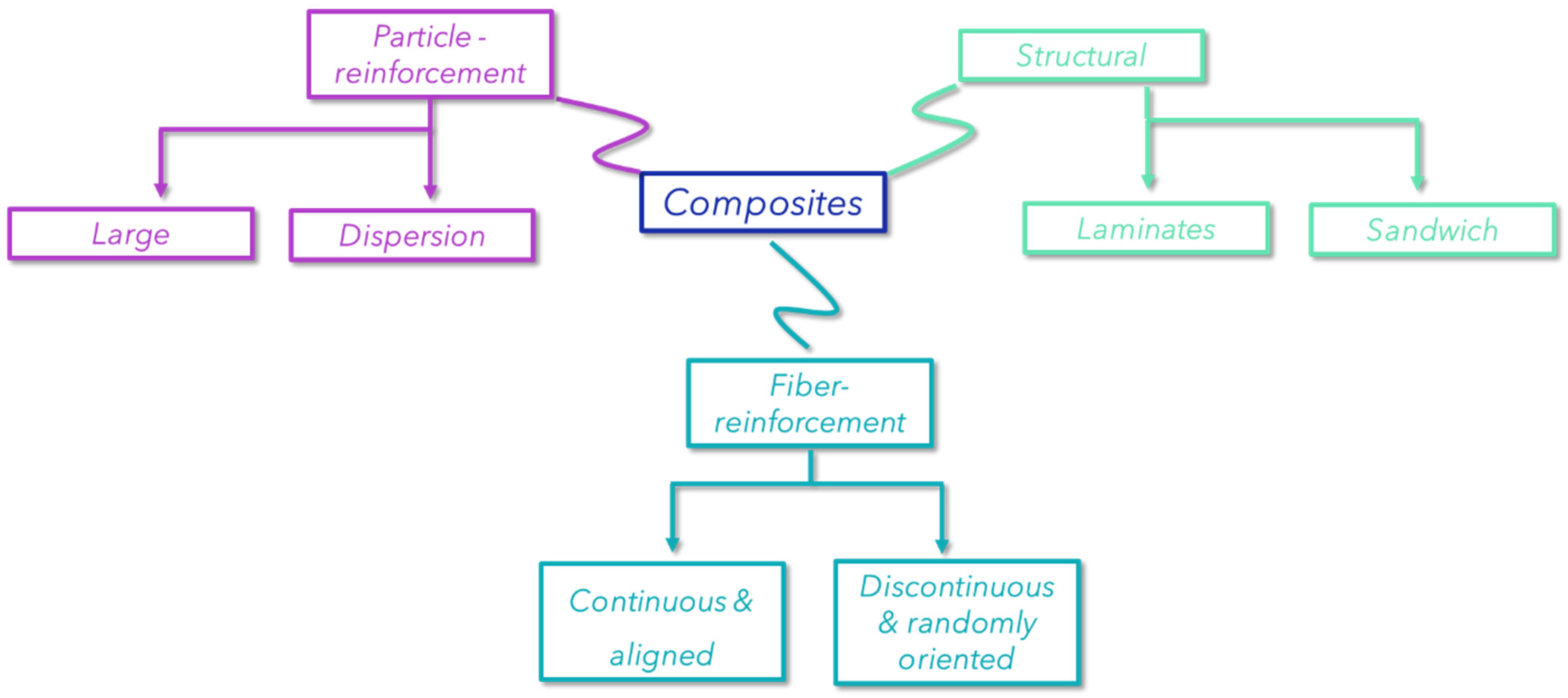


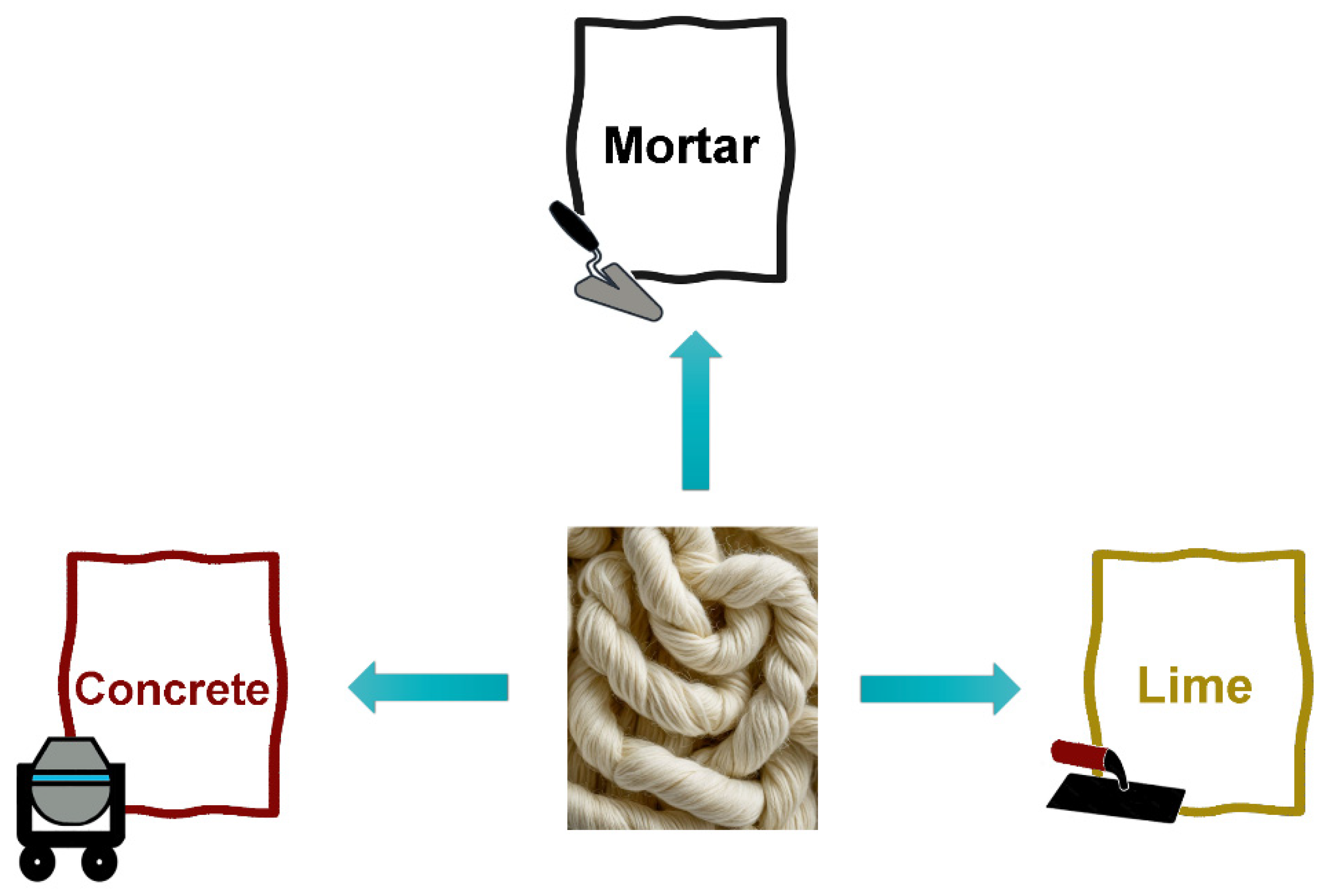
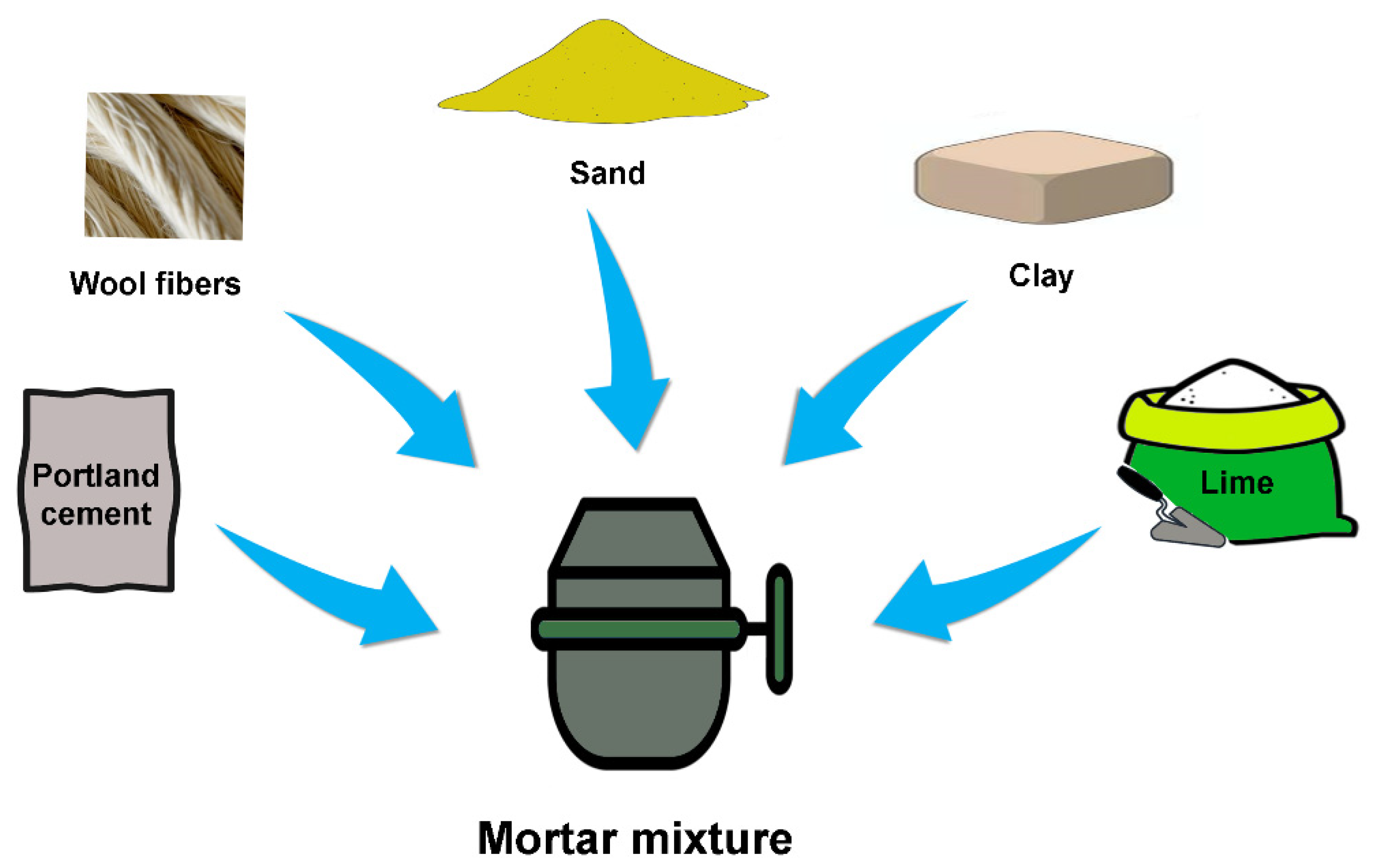

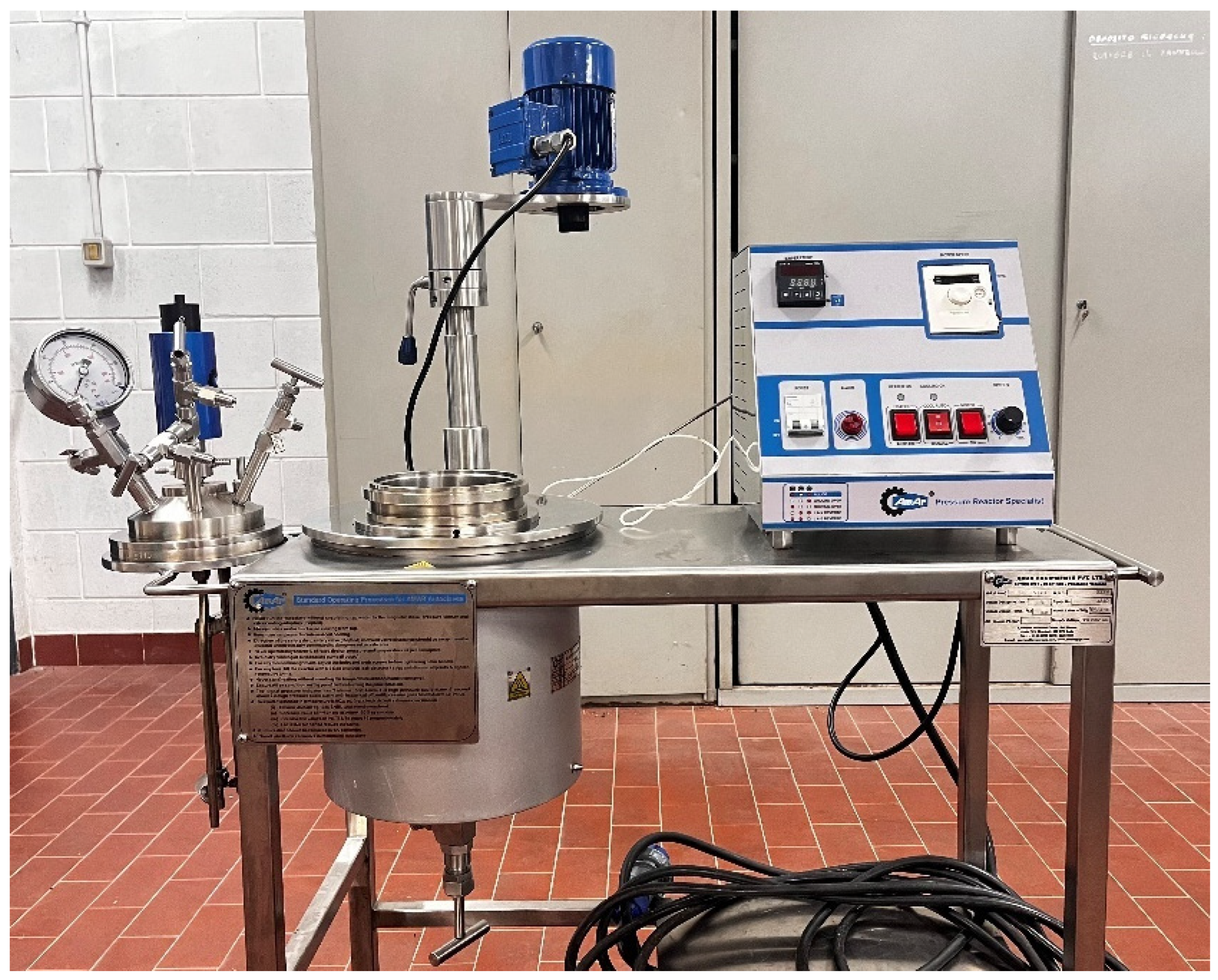

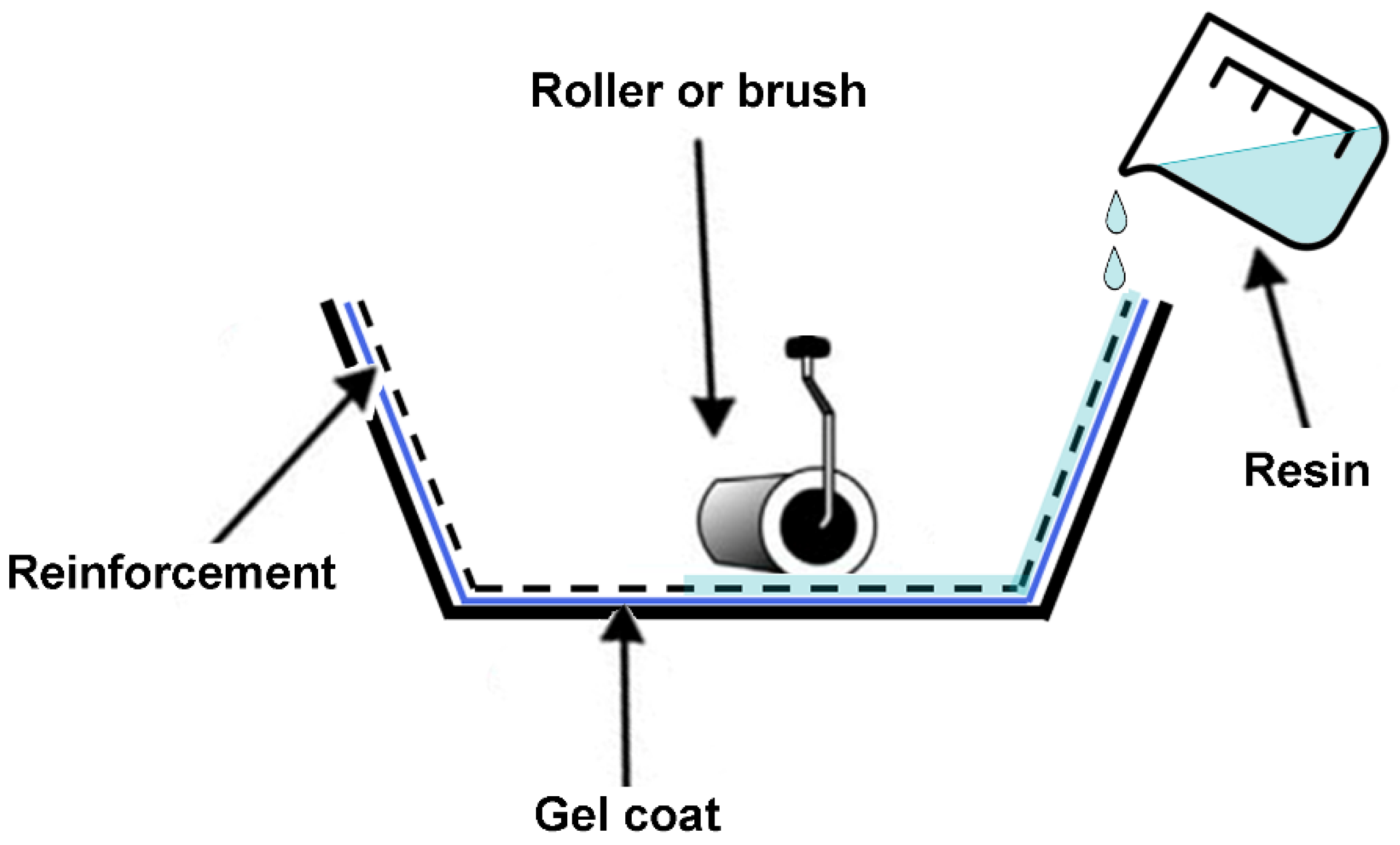


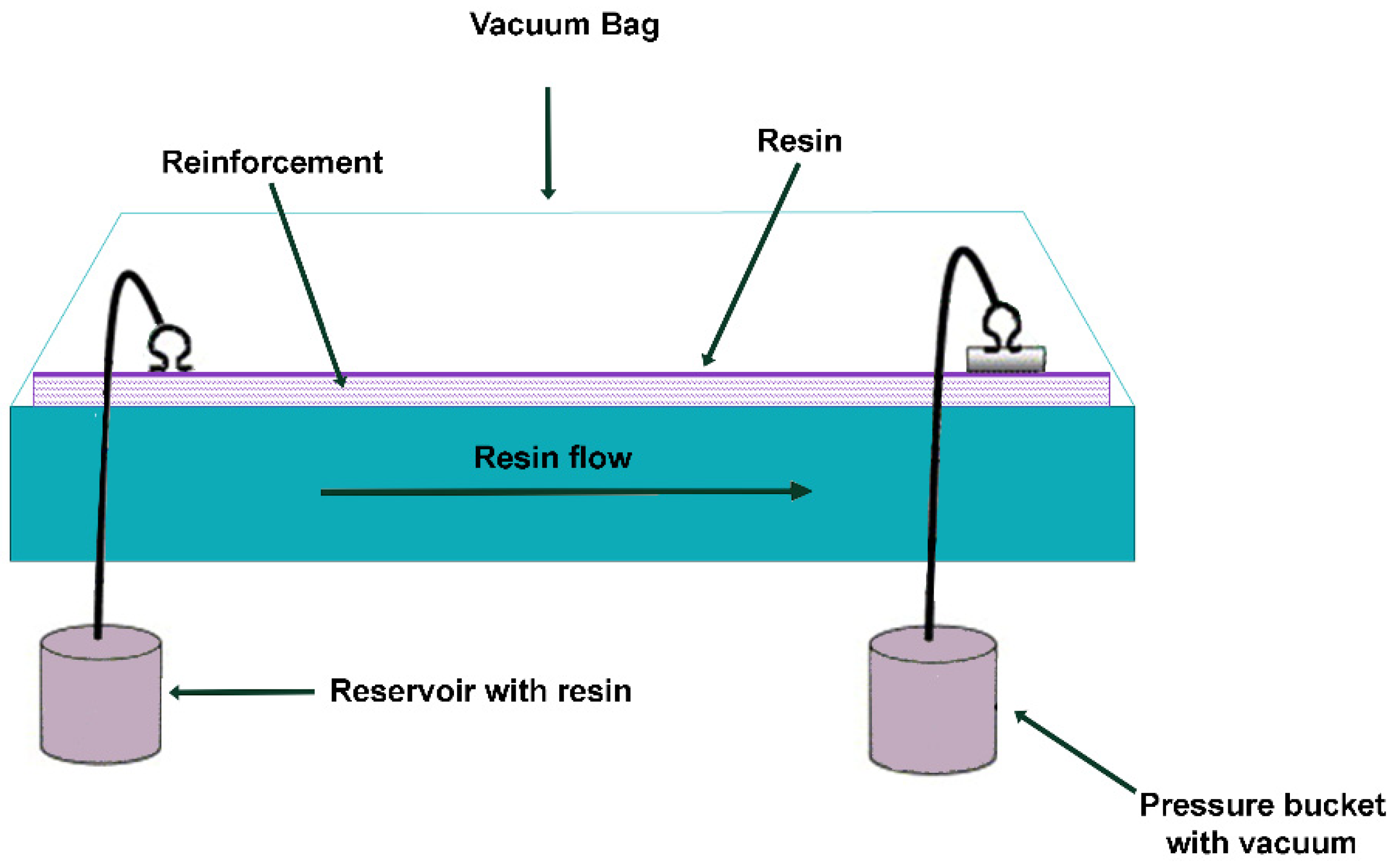
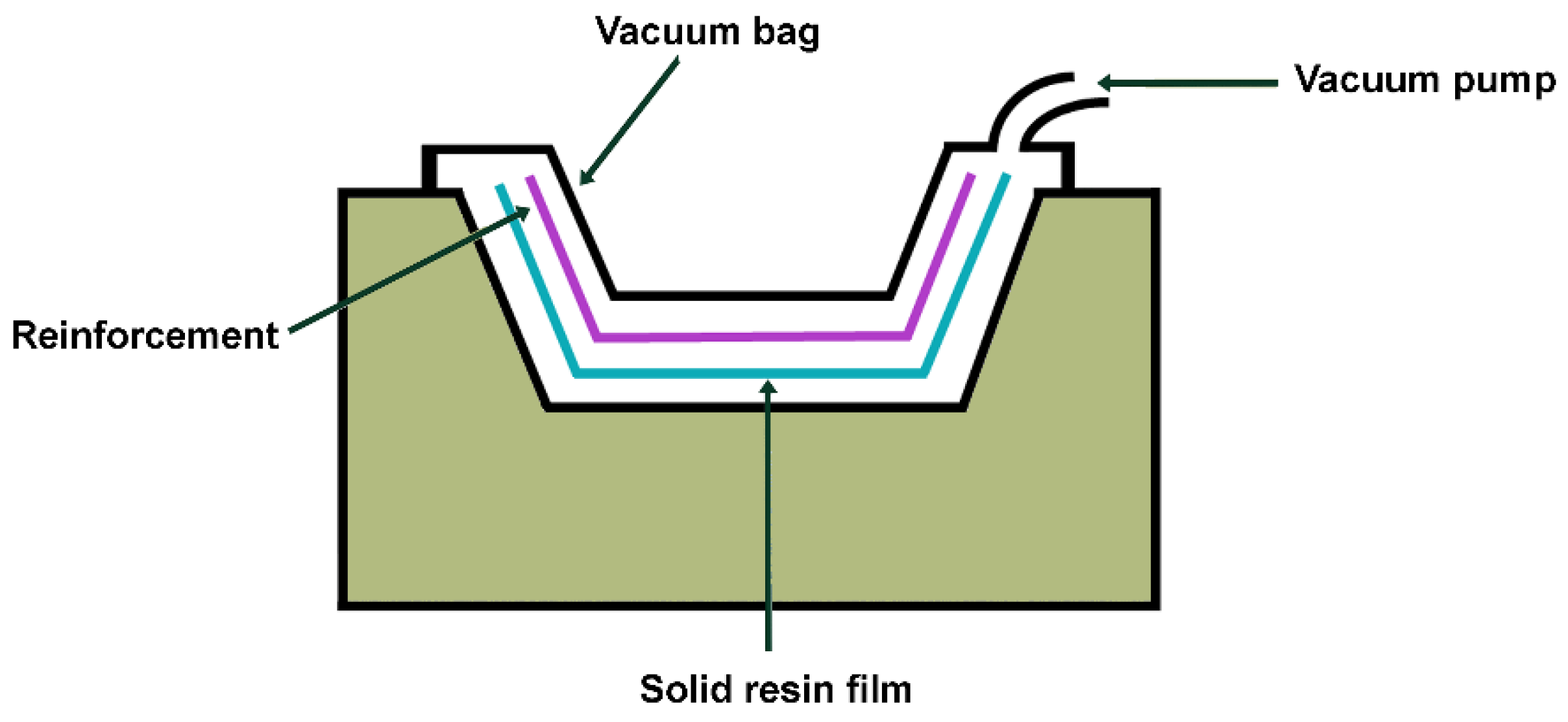

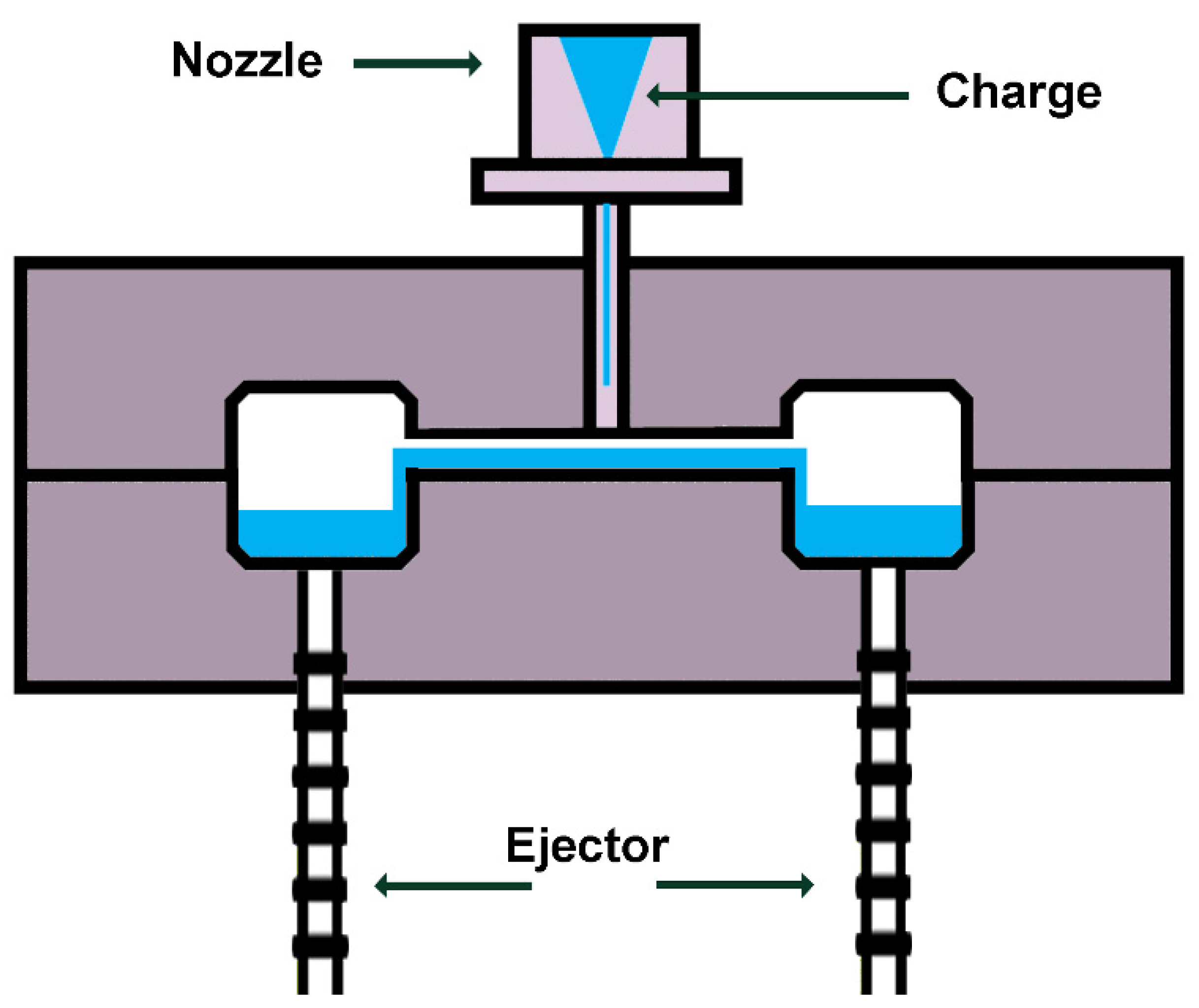
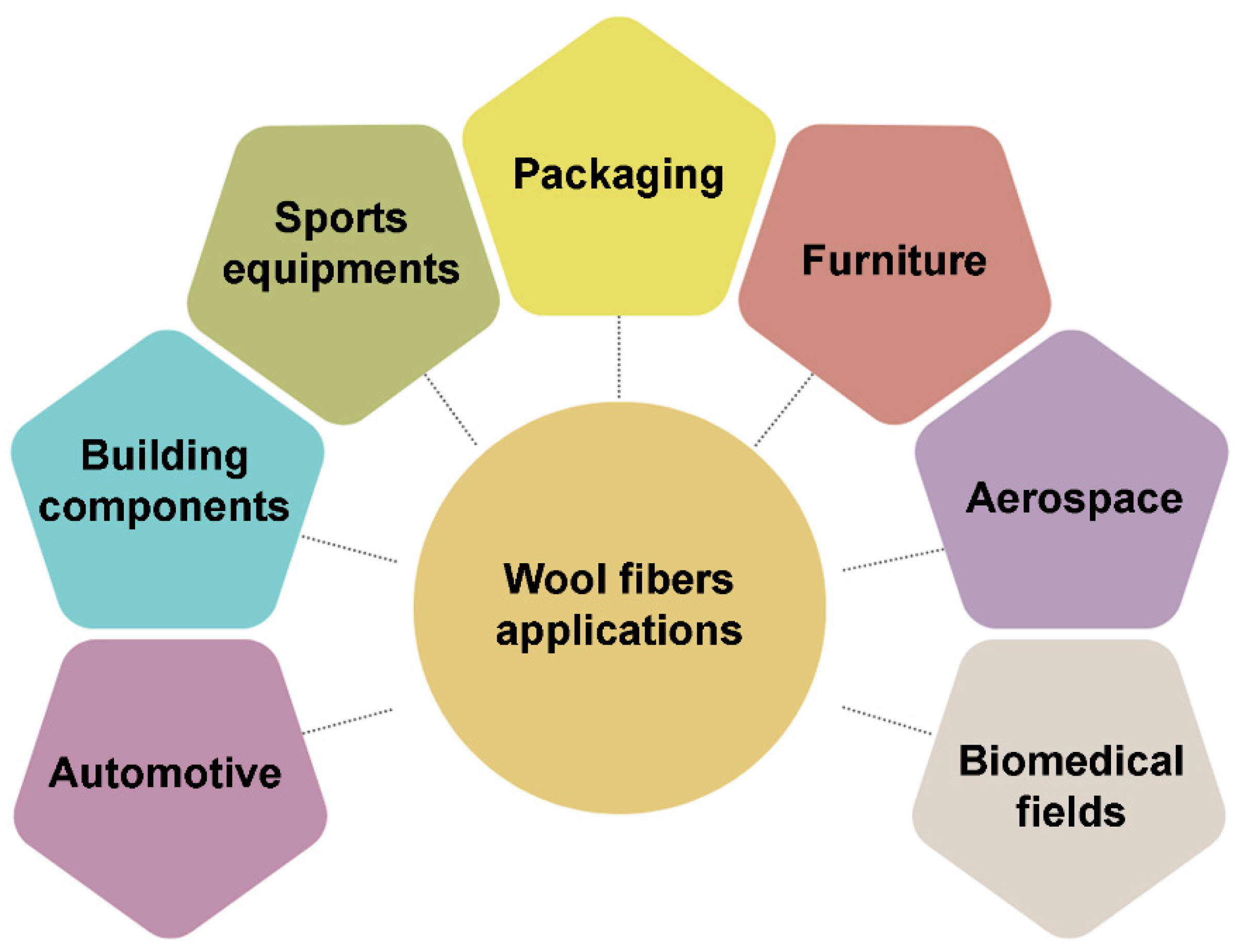

| Classification | Description | Reference |
|---|---|---|
| Fine wool | The fineness of a wool fiber can be used to determine its quality and price. In the international market, wool is typically described as fine when the fibers have a length greater than 65 mm and fineness within a range of 15 to 25 microns. This type of wool can be used to develop luxury fabrics. Fine wool is derived from pure and indigenous breeds, such as merino wool. Nevertheless, crossbred varieties can also be employed to enhance fineness. Morphologic differences are observed between wool fibers classified as fine and other wool fibers. Fine wool exhibits longer fibers, a unique cuticle scale pattern, and typically possesses an ortho- and para-cortical cell structure that is responsible for the natural crimp observed in this fiber type. | [6] |
| Carpet wool | Wool fibers with an average fineness ranging from 30 to 50 µm and a minimum fiber length of 35 mm are generally classified as carpet wool. These can be derived from either crossbred wool, including Lincoln, Romney, Drysdale, and Elliotdale, or wool produced in semi-arid areas. This category encompasses wool fibers with a thickness of 25–31 microns, derived from the crossbreeding of fine wool sheep with local breeds, such as Dorset, Southdown, and Suffolk. In the case of carpet wool, the ortho-cortical cell is surrounded by the para-cortical cell, resulting in a reduction in crimp and a corresponding increase in marginal mechanical properties. | [7,8] |
| Coarse wool | Wool fiber with a fineness of 50–80 μm and 40–80% hairy-type continuous medullation is regarded as coarse wool. This wool can be derived from sheep of the arid and semi-arid areas. In comparison to fine and carpet wools, coarse wool exhibits a reduced proportion of ortho-cortical cells relative to para-cortical cells, which results in a compromised tensile strength. Moreover, the majority of coarse wool and hair are naturally pigmented | [9] |
| Kemp wool | Wool fiber with a fineness of more than 60 μm and a continuous medullation of more than 80% is considered kemp wool. The wool in question can be derived primarily from the mutton sheep breed, which is generally considered to have a lower economic value due to its poor quality. It is brittle in nature due to the absence of crimp, chalky white in color, and exhibits a lack of exhaustion when dyed. Additionally, it is relatively weak. They are employed principally as a constituent of blended products with coarse wool for technical textiles and floor coverings. In kemp wool, the proportion of cortical cells to the entire fiber is less than 20%. | [7,10] |
| Material | Thermal Conductivity (W/m K) | Sound Adsorption Coefficient (α) | Advantages | Disadvantages | References |
|---|---|---|---|---|---|
| Wool | 0.04–0.06 | 0.70–0.90 | Renewable, biodegradable, excellent insulation properties | Sensitive to moisture, may require treatment for durability | [16,33] |
| Rock wool | 0.03–0.04 | 0.90–0.95 | High insulation efficiency, fire-resistant | Non-biodegradable, can cause skin irritation | [34,35] |
| Polyurethane | 0.02–0.03 | 0.50–0.70 | Lightweight, excellent thermal insulation | Non-renewable, emits toxic gases when burned | [36,37] |
| Hemp Fiber composite | 0.04–0.06 | 0.60–0.80 | Renewable, biodegradable, good insulation properties | Variable quality, sensitive to moisture | [38,39] |
| Cellulose insulation | 0.04–0.045 | 0.70–0.85 | Recycled material, good thermal and acoustic insulation | Can settle over time, sensitive to moisture | [40,41] |
Disclaimer/Publisher’s Note: The statements, opinions and data contained in all publications are solely those of the individual author(s) and contributor(s) and not of MDPI and/or the editor(s). MDPI and/or the editor(s) disclaim responsibility for any injury to people or property resulting from any ideas, methods, instructions or products referred to in the content. |
© 2024 by the authors. Licensee MDPI, Basel, Switzerland. This article is an open access article distributed under the terms and conditions of the Creative Commons Attribution (CC BY) license (https://creativecommons.org/licenses/by/4.0/).
Share and Cite
Patrucco, A.; Zoccola, M.; Anceschi, A. Exploring the Potential Applications of Wool Fibers in Composite Materials: A Review. Polymers 2024, 16, 2360. https://doi.org/10.3390/polym16162360
Patrucco A, Zoccola M, Anceschi A. Exploring the Potential Applications of Wool Fibers in Composite Materials: A Review. Polymers. 2024; 16(16):2360. https://doi.org/10.3390/polym16162360
Chicago/Turabian StylePatrucco, Alessia, Marina Zoccola, and Anastasia Anceschi. 2024. "Exploring the Potential Applications of Wool Fibers in Composite Materials: A Review" Polymers 16, no. 16: 2360. https://doi.org/10.3390/polym16162360
APA StylePatrucco, A., Zoccola, M., & Anceschi, A. (2024). Exploring the Potential Applications of Wool Fibers in Composite Materials: A Review. Polymers, 16(16), 2360. https://doi.org/10.3390/polym16162360








